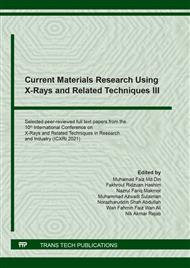p.74
p.80
p.86
p.92
p.105
p.110
p.119
p.125
p.130
Correlation of Humidity and Mechanical Properties of Different Grades of RT-PMMA
Abstract:
The implementation of glass in various industries may cause some problems due to its brittleness characteristic. Its usage in the transportation sector has led to death and serious injuries to drivers and passengers in vehicles. It shows that the manufacturing process of the materials used requires an improvement in terms of brittleness to provide better protection to the consumer. Therefore, rubber toughened PMMA (RT-PMMA) was introduced as the rubber has the ability to increase the ductility of PMMA. PMMA and two different grades of RT-PMMA namely RT-PMMA65 and RT-PMMA100 were taken into consideration to investigate the effect of different rubber contents on the ductility of PMMA. Other than strain rate and temperature, humidity is also one of the factors that affect the ductile properties of PMMA. In this study, tensile tests at different humidity levels (11% and 98%) will be carried out by immersing the specimens in two different solutions which are lithium chloride (LiCl) and potassium sulfate (K2SO4) beforehand. The output from the experimental works proved that the tensile properties of RT-PMMA are affected by the presence of humidity for all three grades of PMMA under consideration. It is also proved that RT-PMMA100 is more ductile compared to RT-PMMA65 on the tensile test.
Info:
Periodical:
Pages:
105-109
Citation:
Online since:
January 2022
Authors:
Price:
Сopyright:
© 2022 Trans Tech Publications Ltd. All Rights Reserved
Share:
Citation:


